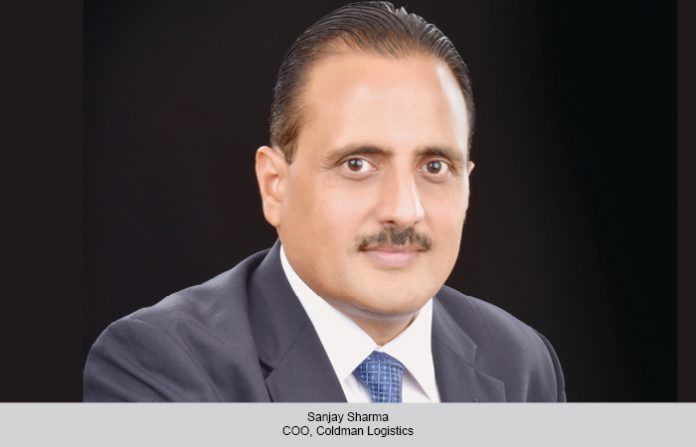Surge in m-commerce has intensified inventory turnaround cycles, straining warehouse operations. To address this, we have implemented upgrades to our systems, enabling us to accommodate higher inventory throughput, while providing clients with real-time visibility into their inventory, says Sanjay Sharma, COO, Coldman Logistics.
Ritika Arora Bhola
Take us through the recent developments at Coldman Logistics to boost cold chain infra and logistics?
We have been on an expansion trajectory since our inception. In the past fiscal, we have added 20,000 pallets of temperature-controlled warehousing capacity across India. Our commitment to delivering excellence is reflected in our state-of-the-art facilities. Demonstrating our unwavering commitment to quality, four of our temperature-controlled warehouses underwent rigorous unannounced quality audits, achieving exceptional results. These facilities have been awarded AA+ BRCGS certification, affirming our adherence to the highest standards in storage and distribution practices.
Tell us about infrastructure and facilities at Coldman warehouses to facilitate ease of doing business?
In the global cold chain industry landscape, advancements have been witnessed in technology, structurally as well as operationally, over the past decade. At Coldman, we are enhancing our WMS to adapt to the evolving demands of our business environment. The surge in m-commerce has intensified inventory turnaround cycles, straining our warehouse operations.
To address this challenge, we have implemented robust upgrades to our systems, enabling us to accommodate higher inventory throughput, while providing clients with real-time visibility into their inventory. This enhancement facilitates accurate demand planning and ensures seamless operations. Recognising the importance of sustainability, we are committed to reducing our reliance on conventional energy sources. Through the integration of solar and wind energy solutions across our facilities, we have achieved a milestone, with 50 per cent of our capacity powered by solar energy. This achievement reflects our dedication to environmental stewardship and operational efficiency.
How would you rate infrastructure for cold chain movement? Is it good enough or is there room for improvement?
The cold chain infrastructure is improving rapidly in terms of quality as well as capacity. The evolving consumer habits, especially among Gen Z, are driving the industry forward, resulting in increased interest from major players and investors. One of the key challenges faced by the Indian market is its vast geography and fragmented reach, which makes it difficult to cater to all markets. Despite this challenge, there is optimism as the government is actively addressing connectivity issues through initiatives such as the development of highways and dedicated corridors. These efforts are likely to simplify and accelerate the reach of cold chain services across India the country in the coming years.
What are the challenges in the cold chain sector? Can you suggest solutions to resolve the issue?
The lack of emphasis on quality, results in compromised infrastructure within the cold chain sector. This is the main challenge. This neglect of food safety standards frequently occurs due to various cost pressures, which, in turn, leads to compromised supply chain processes. It is imperative for food regulatory authorities to enforce quality norms and ensure that food safety standards are upheld without compromise. Only through implementation of these standards can the integrity of the cold chain be maintained, safeguarding both consumer health and the reputation of the industry.
What would you like to say on the govt’s initiatives, boosting multimodal connectivity?
The government’s initiatives to boost multimodal linkage hold immense potential for driving economic growth, streamlining logistics efficiency, and elevating overall transportation infrastructure. The large logistics hubs shall improve connectivity and make the transit times efficient thereby reducing the operating costs, which shall further benefit the industry. From a cold chain perspective, enhancing coastal connectivity is imperative. With a concentration of marine export processing units along the coastal belt, improving coastal connectivity would benefit the Ready-to-Cook/Ready-to-Eat industry. This improvement would not only expedite the reach of products but also result in cost savings, making transportation economical. The government must integrate the food processing units along these centres for reducing food wastage significantly.
How crucial is the role of technology in enhancing operational efficiency and reducing costs?
Technology enables data collection, analysis, and utilisation for informed decision-making and improvement in the cold chain industry. Analysing temperature profiles, transportation routes, inventory levels, and customer demand helps identify trends and optimise resource allocation. By enhancing efficiency and reducing wastage, technology-driven solutions cut costs throughout the cold chain. For instance, improved route planning minimises fuel consumption, while advanced inventory management reduces overstocking and holding costs. While industry data on investment is hard to forecast as cold chain footprint in India is limited and hence its more of adoption of best practices.












